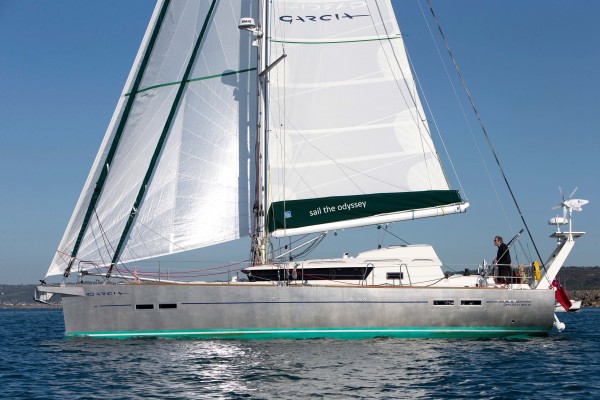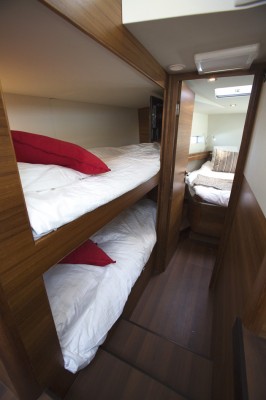Cruising guru Jimmy Cornell has put his years of experience into a new boat for world cruising. Matthew Sheahan finds her an extraordinary and exciting go-anywhere cruiser
Plot Jimmy Cornell’s cruising tracks on a map of the world and you’ll end up with a picture that looks much like the global route map in the back of the British Airways in-flight magazine.
With so many trails stretching back and forth across every ocean on the globe, Cornell’s lifetime of cruising makes for a cat’s cradle of offshore passages. The message is clear: there are few places that Jimmy Cornell hasn’t been since he first set off with his young family in 1975.
That first trip turned out to be a six-year cruise taking in 70 countries and 68,000 miles and the beginning of an extraordinary career that became the inspiration for thousands of others. His most famous achievement is setting up the Atlantic Rally for Cruisers, the ARC. Now approaching its 28th year and run by World Cruising, the transatlantic cruise-in-company has seen a total of 5,091 boats cross the Atlantic from the Canaries to the Caribbean over the years.
20,000 miles of cruising
So with over 200,000 miles under his belt and having owned three bluewater cruisers already, it is hardly surprising that when it came to explaining what he wanted for his next boat, Jimmy Cornell had some firm views. But even by his own globe-trotting standards, he upped the ante when he decided that his new yacht would not only need to be the perfect bluewater cruiser, but also be capable of negotiating the North West Passage.
The Garcia Exploration 45 is the product of this challenging brief. But as we were to discover when we headed to Cherbourg to visit the yard and test the boat, she is much more than simply one man’s dream boat.
Cornell’s books, charts and rallies have created a new ambitious cruising niche to leave the popular routes and venture into more remote territories. And while many of the world’s leading upmarket bluewater cruisers are capable and versatile yachts, there appears to be a growing desire for something even more robust: a go-anywhere boat.
With five boats sold and in build before the first boat was even launched, the Exploration 45 is evidence of a growing appetite for this mix, a modestly sized, multi-purpose sailing off-roader.
The concept
“He’s a genius,” declared Cornell, showering the boat’s designer, Olivier Racoupeau, with praise as we stepped aboard. “He listened, he understood and came up with exactly what I wanted.”
The fact is that from the moment you see her it is clear that Aventura IV is indeed something very different from the norm. Angular and muscular in shape and style, she has a natural alloy finish to her hull that says go-anywhere from the outset. Like a Severn class lifeboat compared with a typical flybridge cruiser, there is a ruggedness in both her looks and construction that will bring out the explorer in you faster than you can pack your bags and hide your car keys on the front tyre.
From her boxy alloy bowsprit with its large and dedicated anchor stowage and warp fairleads, to the chunky welded-on horn cleats on the bow and tubular grabrails on the coachroof, any one of these items looks capable of lifting the entire boat let alone performing the more specific role for which they were intended.
The deck-stepped mast is surrounded by tall granny bars at its base, another indication of a deck that has been designed and built to be worked safely and securely in lively conditions. When you take a look at her deep and well-protected cockpit all the essential control lines are not just led back aft, but to positions where they can be worked easily. Her twin wheels and comfortable seating positions allow good visibility forward and are further indications of a carefully considered layout.
Excellent shelter
But there are two details in particular that really set the tone. One is the coachroof overhang in the cockpit that provides excellent shelter for those sitting at the forward end. Similar to the style that has been popular aboard Open 60s for many years, this simple, but highly effective configuration dispenses with the need for a flimsy and vulnerable spray dodger yet still provides good protection further aft for the helmsman. The design of this roof is clever in that it neither looks agricultural nor does it hinder your visibility ahead.
The second, and to my mind one of the clearest indications of the faith you can place in this boat, is the companionway doors. Built as if the crown jewels lay behind, these have to be the toughest doors I’ve ever seen on a yacht. They close with a reassuring thud and as you swing the handle and the bolt locks top and bottom to seal you in.
All you need to worry about now is the severity of the weather that might have forced you below decks in the first place. But the bottom line is simple and clear: when you need to batten down the hatches, this is a tank of a boat.
Under sail
Under way she’s anything but a tank. She may be 14 tonnes, built in aluminium and have twin rudders, but even in light airs she slipped along well and was responsive on the helm. This light touch was particularly impressive, not just because she has two rudders, but because for safety’s sake she has two independent steering systems that are also linked, a feature that often makes for a heavy helm.
Contributing to this balanced feel and good windward ability is the centreboard which, when lowered, draws a healthy 2.80m. When raised, the draught is not only reduced to just 1.05m, but the board retracts completely into the hull/skeg allowing her to dry out with athwartships support from the twin rudders.
Interestingly for a bluewater cruiser, the rudder blades are semi-balanced and only have short skegs, a feature that helps achieve the light feel on the helm. For protection, the blades have a sacrificial element not at the tip where you might expect it, but at the top of the blade – the rationale being that if they hit something, the stock will bend aft and push the upper aft surface against the hull. Here the sacrificial part, which is a lightweight alloy frame around a foam core, will bend or pop out and allow the rudders to continue to articulate.
Another interesting detail is the ability to pump fresh water from side to side to act as ballast, which increases her righting moment and improves her performance. Keeping weight out of the ends minimises pitching. Here, the anchor chain well is just forward amidships with the chain led back through a tube under the deck.
Her basic sailplan is a cutter configuration using rope-driven furlers for the genoa and staysails. A tack point for a Code 0 or an asymmetric spinnaker is provided at the outer end of the bowsprit. Again, the Code 0 option has a furler unit, this time a continuous line-driven unit to unfurl and recover the sail.
The mainsail is a slab reefing type that uses a stack pack- type boom bag with lazyjacks. The 4:1 mainsheet system is anchored to the coachroof top to keep it out of the cockpit but unlike many other similar configurations is far enough aft to allow a good mechanical purchase.
A cockpit arch is mounted abaft the pushpit and provides a solid, dedicated mounting for the wind generator, solar panel and satcom dome. The fact that the arch is raked aft also means that this can be used to help raise, lower and stow the dinghy on the transom.
In addition to providing a walkthrough to the sugar scoop-style transom, this aftermost area includes reels for stowing the aft warps, a locker for the kedge aft anchor, easy to access gas lockers (one for butane and one for propane), a boarding ladder, large grabhandles, plus a bracket on the centreline onto which the dinghy outboard can be mounted to provide engine power in the event of a main engine failure. This bracket would more commonly be used to mount the Sail-Gen power generator.
Below decks
Like many semi-custom boats, it is the layout below decks that will attract the most comment. Cornell’s boat will be no exception. He required eight berths in four cabins so that he could cruise with his family and friends. Admittedly, the forward double is the owner’s cabin and for use at rest, but sailing with six aboard a 45ft bluewater cruiser has meant some compromises, principally reduced stowage volume.
Whether you agree with his final layout hardly matters as the semi-custom nature of this boat means that owners can either take the standard proposed configuration or develop their own. What does matter is the broad configuration and the standard of fit-out – I loved both.
The raised saloon layout has been arranged so that the navigation station is right forward and sits on the centreline. From here, thanks to the forward-facing and side windows in the coachroof superstructure, you get a terrific 270° view, something that Cornell was insistent on. With plenty of area for mounting instruments and a decent-sized chart table this is a practical, secure and comfortable place not just to navigate, but to stand your watch if required.
I also liked the longitudinal galley, from the ample worktop space to the drawer-style fridge as well as the assurance that you can move about this area when the boat is heeled. As with all decksaloon and pilothouse configurations there will be those who criticise the variety of different cabin sole levels and liken living aboard to spending weeks climbing stairs.
But the different levels are there for a purpose: to provide excellent visibility where it matters and keep the weight and superstructure down where it doesn’t. And so to her build quality which is the easiest aspect to describe – excellent.
Dimensions
LOA 14.72m/48ft 4in
LWL 12.34m/40ft 6in
Beam (max) 4.43m/14ft 6in
Draught 2.80-1.05m/9ft 2in-3ft 5in
Displacement 14 tonnes/30,864lb
Ballast 4.5t/9,920lb
Sail area 93.2m2/1,003ft2
Engine 75hp
Water 500lt/110gal
Fuel 700lt/154gal
Sail area:disp 16.3
Disp:LWL 207
Price ex VAT €425,000
This is an extract from a feature in Yachting World August 2014 issue












